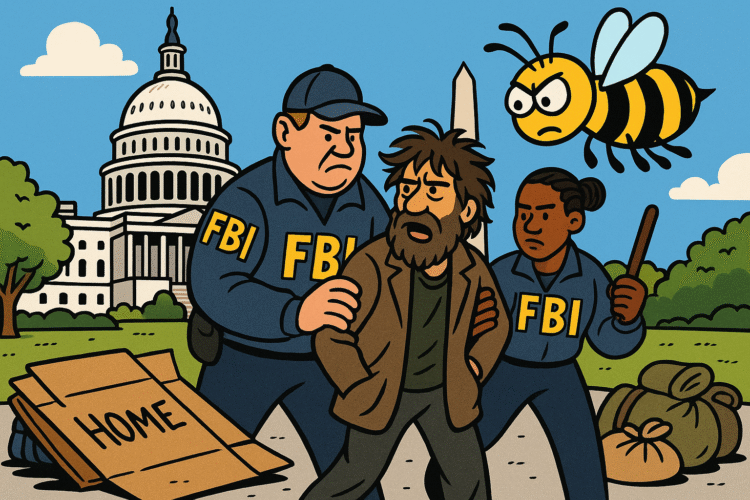
The nation’s capital has always been a theater for spectacle—power lunches, political scandal, and monuments that double as photo ops for eighth-graders on field trips. But this week, President Trump decided the city’s most enduring monument—its unhoused population—was not photogenic enough for the coming election season. In an announcement delivered with the kind of theatrical flourish that could only be born from decades of branding everything from steaks to universities, he ordered homeless individuals in Washington, D.C., to “move out” immediately.
And because no reality-TV presidency is complete without a subplot involving federal law enforcement, the FBI is reportedly stepping up involvement in the enforcement effort. This, of course, raises the obvious question: when the people in your city already have nowhere to go, why not make it a federal case?
From “Urban Revitalization” to “Urban Eviction”
In the grand tradition of euphemisms that turn cruelty into campaign fodder, the administration is calling it “Urban Renewal 2.0.” Gone are the days when “revitalization” meant a farmers’ market and a wine bar opening next to a bus stop. Now it’s a cross-agency, militarized relocation program, complete with logistics that would make FEMA blush. Imagine urban planning, but the blueprint is just a blank map with the words “Not Here” scrawled across it in Sharpie.
The policy’s supporters have hailed it as “common sense” and “necessary for safety,” which is political shorthand for “no one in our donor network wants to see a tent while sipping rooftop cocktails.” Opponents, meanwhile, have pointed out the glaring problem: there’s no plan for where people are supposed to go. The press conference answer to this was a vague gesture toward “other places,” which sounds less like policy and more like an ex breaking up with you by saying, “You’ll find someone else.”
Federal Muscle for a Local Problem
The FBI’s involvement is perhaps the most surreal twist. Traditionally tasked with preventing terrorism, dismantling criminal syndicates, and occasionally showing up in prestige dramas as the brooding moral center, they’re now being cast as street-level relocation agents. The sight of a bureau windbreaker—once shorthand for “we caught the mob boss”—now potentially signaling “we’re here to fold your tent” is a shift in brand identity so severe it would make Madison Avenue consultants weep.
There’s no word yet on whether the bureau is receiving special training for its new role. One imagines seminars on “Eviction Etiquette” and “Best Practices for Confiscating a Shopping Cart Without Breaking Public Relations.”
The Optics Olympics
For an administration obsessed with stagecraft, the visual narrative is everything. A city cleared of visible poverty makes for better television, better rally footage, and better background for impromptu press briefings. It’s not that the problem is solved—it’s just that the camera pans a little wider, the barricades a little higher, and suddenly the streets look like something you could sell in a real estate brochure.
Of course, for those actually living on those streets, the optics game is less about narrative and more about survival. The “move out” order doesn’t come with vouchers, housing, or even a map to the mythical “other places.” It’s just a shove toward invisibility, dressed up in the language of order and civic pride.
A History Lesson in Selective Intervention
It’s worth noting that Washington, D.C., has had a visible unhoused population for decades. Politicians have campaigned through it, around it, and occasionally on top of it (figuratively, though you wouldn’t put it past some). Yet only now, in the thick of political theater season, is the problem deemed urgent enough for federal intervention.
This selective urgency is a hallmark of governance as performance art: emergencies that align with optics get helicopters and press conferences; emergencies that don’t get advisory committees and expired grant applications.
Where the Ledger Balances
For those who frame life in D.C. as a ledger—debits of public nuisance, credits of civic beauty—this is a calculated write-off. The unhoused are considered a liability on the city’s balance sheet, their presence subtracted from the “marketability” of the capital. The solution is to erase the number, not fix the equation. It’s fiscal policy by way of magical thinking: if you can’t see the deficit, maybe it’s gone.
A City of Ghosts in Waiting
If the plan “works,” the capital may indeed be quieter, cleaner, more camera-ready. But it will also be emptier in the way only a ghost town can be—haunted not by who’s there, but by who’s missing. And unlike other federal operations, there’s no end date, no mission accomplished banner. Just a steady erasure of the inconvenient, until all that’s left are sanitized streets and the lingering knowledge of what had to be removed to make them so.
Final Thought: You can scrub a sidewalk, you can police a tent line, you can deploy federal agents to erase a problem from view. But the absence will speak louder than the aesthetics, and the silence of a vanished community will be the loudest sound on the Capitol’s marble steps.